
12 minute read
A Living Laboratory
from GREEN TECHNOLOGY
The Need for Greening the Campus
The mission of the Asian Institute of Technology (AIT) is to promote technological changes and sustainable development in the Asia-Pacific region, and to develop highly qualified and committed professionals who play leading roles in the region’s sustainable development and its integration into the global economy.
Advertisement
With an overall curriculum oriented towards preparing students on sustainability, development, and technological issues, AIT is an excellent training ground for the youth who will take up decision-making positions in their respective countries and the region. It is with this mandate that AIT would like to emphasize on setting a living example of a resource efficient and low-carbon campus, where learning about sustainable development is not only derived from theoretical teaching but is reinforced by experiential learning and life on a campus that exemplifies sustainability.
AIT faculty, staff, and students have long been and are addressing these issues in and outside the campus. Often times these projects are time-bound and targeted as capacity building or technology dissemination for external parties and countries. The Institute’s commitment to partners has allowed experts to support sustainability initiatives that are focused on facilitating development in communities, countries, and the region.
Research performed at AIT on sustainability has included studies on the development of a low carbon campus through application of renewable energy, energy efficiency, and energy conservation measures focusing on the mitigation of greenhouse gas emissions, innovative demand side management strategies, and 3R (reduce, recycle and reuse) of wastes.
As AIT endeavors to fulfill its mission, it is increasingly important to adopt a holistic and visionary goal for the campus – a Living Laboratory. Experts at AIT believe that it is the right time to proceed as AIT rebuilds and upgrades its campus, activities, and curriculum after the flood devastated the campus at the end of 2011.
Vision: The Five Year Target
The Living Laboratory will be a change agent that integrates sustainability principles into everyday activities for achieving higher educational and research excellence and contribute to region’s sustainability. By preparing highly capable and dedicated workforce that not only learns, but lives “the sustainability experience” in the AIT campus, AIT can thus serve as a showcase and role model for other educational institutions in the region.
To convert AIT into a sustainable living laboratory will initially start by following the low carbon pathways of living and learning, hence resulting in a self-sufficient eco-community. Sustainability at AIT needs to have its imprint in all spheres of its activities covering curriculum development, research, operation, outreach, among other priority areas.
The journey towards sustainability would take AIT through sustainable and low-carbon pathways highlighted by the wise consumption of goods, waste minimization and recycling, water conservation and reuse, energy efficiency, renewable energy use, agriculture and food, housing and transportation, construction, office automation, information technology, purchasing and procurement, sustainable business practices, and management.
Creating a Green AIT Campus means focusing at least on the following major sustainability themes, including sustainable, green procurement:
1. Energy, water, and waste management (3R - reduce, recycle and reuse), 2. Sustainable transportation, 3. Natural resources and wilderness preservation, 4. Application of information and communication technologies, and others.

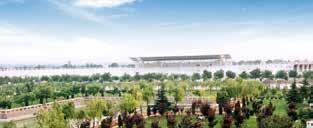
Demonstration Projects for Year 1 and 2
The evaluation of daylight availability in an academic building at AIT was conducted in this study by using a software simulation. This evaluation supported the installation of a light pipe in an area not reached by natural light. Software validation was done by comparing the results of daylight illuminance from the simulation with measured data. Rooms with different window orientation in the reference building were chosen for measurement - facing north, south, east, and facing both south and west. The estimation of daylight availability in the referred building was conducted through 11 representative rooms with various characteristics such as window orientation, number of shading devices, and window areas. The results of daylight availability showed that all rooms in the referred building do not meet the minimum standard of 300 lux as task of office and class room. The rooms need additional lighting from artificial lighting to satisfy the users. Performance lighting was compared beThe following activities will be developed and implemented as demonstration projects:
Baseline Setting: Studies for gathering the overall ecological and/or carbon footprints from waste, wastewater, and energy usage in the Institute.

Waste Reduction, Reuse, Recycle: Mandatory waste segregation for student, staff, and faculty houses, food waste recycling bins, and composting or an anaerobic digestion. Policy to minimize the use of plastic while increasing the use of reusable bags when purchasing items inside the campus.
Water Management and Wastewater Treatment and Reuse: A pilot-scale wetlands system for wastewater treatment.
Energy Efficient Building and Operations: Adding onto the current energy efficient initiatives at the Energy Building and by installing solar lighting in the campus.
Sustainable and Green Purchasing: Preparation of sustainable purchasing code of conduct for office and others in campus.
Documentation and Dissemination of Sustainability Performance
through Interactive “Eco-Campus Web Portal”: Since sustainability is a continuous process, continuous monitoring and evaluation and the dissemination of sustainability performance is essential. The development of an interactive “Eco-Campus Web Portal” could be a part of the entire sustainability plan that can facilitate discussion of sustainability ideas by all stakeholders while serving as a platform for presenting sustainability
Daylight Availability and Light Pipe Application in an Academic Building
indicators and the Institute’s performance. tween the contribution of daylighting and artificial lighting.
Results showed that the illuminations from artificial lighting in some rooms meet the minimum standard and some rooms do not, due to the position of lamps in the workplace, properties of lamp, and types of lamp fixture. When a room/space does not have any windows, it will require lighting from artificial sources throughout the day. Two 3.4-watt LED lamps and 1 36-watt T8 fluorescent lamp have been installed in a corridor (20 hours/ day approximately).
A vertical light pipe was installed at the corridor to provide daylight. The design of light pipe is vertical cylindrical tube with 60-cm diameter, 3.8-m length and 90% reflectance of aluminum tube. It provides sufficient daylight illuminance during 8:00-16:00 hour and meets the minimum level of 100 lux for 5-8 hours/day in a year which can save electrical energy of 107.64 kWh/year. Before installation of light pipe

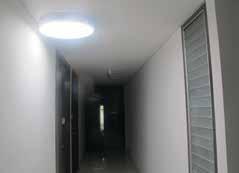
After installation of light pipe
Energy Efficiency
Studies at AIT concentrated on the implementation of energy efficiency and energy conservation of lighting system at selected areas for greenhouse gas (GHG) emission reduction. It was determined that electricity consumption contributed to the highest share of GHG emissions (50%), followed by transportation (37%), waste generation (11%), and others (2%) giving a total of about 15 ktCO 2 eq/year. The average GHG emission of AIT is 4.32 tCO2eq/capita. Policy recommendations for moving towards low carbon campus were also proposed for AIT.
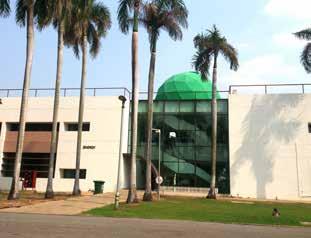
Energy Building
In 2008, a research on the assessment and implementation of technical measures to reduce lighting load was performed at AIT’s Energy Building. This was based on data showing that lighting accounts for an important portion of the Institute’s electricity consumption - about 38% on weekdays and 27% on weekends.
The study determined that the total saving was at least 6,570 THB per month (1,960 kWh) or 78,800 THB annually (23.5 MWh). This accounts for approximately 22% considering savings based on measurements and would also lead to carbon dioxide emissions reductions to 16.9 tons per year.
The electricity consumption was measured before and after the implementation of measures. It was found that electricity consumption was reduced to at least 22 MWh per year (74,000 THB per year) and CO2 emission reduced to 15.6 tons per year. Energy Building
Environmental Engineering and Management (EEM) Building
Completed in May 2010, this study concentrated on implementation of energy efficiency and energy conservation of lighting system at selected areas in AIT for greenhouse gas (GHG) emission reduction. Policy recommendations for moving towards low carbon campus were also proposed for AIT.
The major activities of AIT considered included the analysis of AIT’s carbon footprint. It was determined that electricity consumption contributed the highest share of GHG emissions (50%), followed by transportation (37%), waste generation (11%), refrigerant leakage (1%) and stationary combustions (1%) giving a total of 14,895 tCO2eq/year. The average GHG emission of AIT is 4.32 tCO2eq/capita.
50% 37% 11% 2%
= 14, 895 tCO 2 eq / year
The implementation of energy efficiency and energy conservation measures during a period of 16 weeks at the EEM laboratories resulted in the overall electricity saving of about 30%. Implementing energy efficient technologies contributed to 20% while energy saving promotion and awareness programs saved 10%. The results were evaluated through interviews and measurements after implementation of all activities. In terms of monetary value, the study determined that almost 17,000 THB per month can be saved with a one year payback period of energy efficiency measures.
30% Savings =
Electricity 93,000 kWh per year
BMonetary Value 519,000
CO 2
Reduction 58,962 kg CO2eq
In terms of monetary value, the study determined that an approximate 17,000 THB per month can be saved with the payback period of energy efficiency measures was about one year.
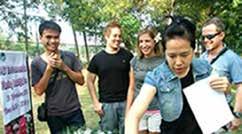
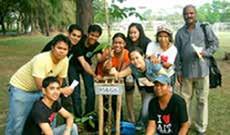
Biogas and Anaerobic Digestion
Managing Organic Waste in AIT with Dry Anaerobic Digestion
According to the waste audit conducted in 2006, the Institute generated about 2 tons of waste each day, and 60% of which was organic waste. Paper and cardboard shared a larger proportion. Fifty percent of solid waste generated from AIT administrative offices were paper.
Material and energy recovery from these organic fractions of the waste is possible with technologies like Composting and Anaerobic Digestion (AD) respectively.
On-site decentralized AD system proves beneficial to a closed or small community living such as university campuses, considering it reduces the waste sorting, handling and transporting, as well as full utilization of the energy recovered back into the community.
The AIT campus successfully demonstrated the production of biogas from organic fractions of waste such as paper waste, vegetables, and fruit waste using the dry AD. Dry AD with thermophilic condition facilitates higher organic loading rates and provides improved process performance and bio
House Holds & Restaurants
Food, Vegetable and Fruit Waste
Paper Waste
Anaerobic Digester Market
Leaves Waste
Schools & Offices
House Holds & Municipal Services
Decentralized AD in a small community gas yield than the wet process under hemophilic condition.
The most critical step is the feed preparation. Shredded paper (10-15 mm) was mixed with other putrescible municipal solid waste (MSW) to maintain the optimum C:N ration and high organic loading because paper waste usually have very high carbon content but less than 0.05 % nitrogen. During the startup period, an active and homogeneous inoculum consisting of cow dung, anaerobic sludge, and anaerobic reactor digestate can be used. In addition, pH was maintained at 7. The system produced a methane yield of 1630 L/kgVS/d in dry condition. Even in a semi-dry condition, the biogas yield was 1445 L/kgVS/d more than in wet condition. The digestate was further treated and used as a soil amendment product.
As AIT is envisioning to transform into a sustainable living laboratory, translating this successful demonstration of a pilot scale decentralized dry AD serves a perfect home-brew technology solution for the organic waste and energy management of the institute.
Minimize source segretgation Biogas (Renew able Energy)
Municipal Solid Waste
OF-MSW (market waste)
Other Waste
Optimize Feed C/N (Avoid Ammonia inhibition)
Landfill
A conceptual approach of dry AD
Dry Anaerobic Digestion
Digestion
Drying
Soil Conditioner
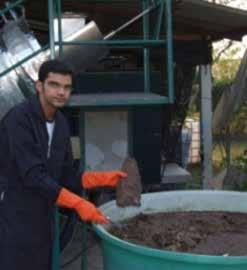
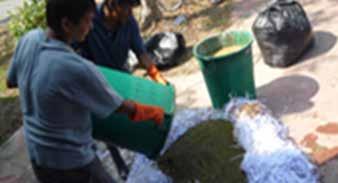
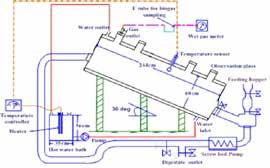
Realising AIT’s Living Laboratory
AIT’s academic activities through applications oriented towards innovative curriculums and programs were a model for Asia in the last century. In the 21st century, when Asia is expected to lead the world, the need for sustainability concepts being imprinted on the decision makers is more relevant. Therefore, the concept of a Living laboratory is being initiated, and it is believed that this can have far reaching influence in the coming years, in the region and the world.
The potential impacts of AIT’s Living Laboratory are long-term and transformative:
Students, staff, faculty and residents witness and live in an environment where sustainability principles are adhered to on a daily basis Visitors and potential donors would be inspired by the way AIT demonstrates its vision
Resource efficiency will be improved, leading to financial benefits, as co-benefits to the institute
Academic institutions have long been agents of change – catalysts for action and centers of learning. Realizing a Living Laboratory in AIT will advance the boundaries of knowledge; inspire leaders, decision-makers, and teachers; and play a significant role in promoting responsibility for generations to come.
Thanks to initial seed fund from the French Agency for Energy and Environmental Management (ADEME), the following activities were initiated in March 2014 as part of the Green Campus Initiative and the demonstration activities for the year 1 and 2.
Wastes at AIT: Generation, Reduce, Reuse, Recycle, and Disposal Water consumption and waste water Collection, management, and disposal of hazardous and toxic waste Lighting electricity consumption reduction Green sustainability of cooking facilities Promoting participatory homestead sustainable vegetable production
Healthy AIT Eco- Campus through Greener and Diverse Wetlands: Ecocity Approach Promoting bicycle-access to harmonize walking and cycling Web-based water level and water quality monitoring system using open-field server
The results of these initiatives are expected to lead to more activities for a greener AIT.

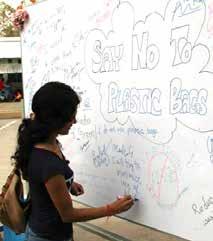
AIT Sustainability Club
AIT Sustainability Club
The AIT Sustainability Club was initiated in February 2014 and currently boasts of over 100 members. As one of the first activities of the club, plastic bag use was reduced in the campus and replaced with cloth bags. With a donation of more than 50 cloth bags, the volunteers of the club provided these cloth bags to the grocery store, Lawson 108 shop, and other outlets in the campus. Customers of these shops can now use these bags as they purchase goods and return the empty bags to the shops or to predetermined spots in the residential areas. The initial response from the AIT community has been very positive; expansions of this activity are being planned.
The AIT Sustainability Club meets twice a month (2 nd and 4 th Thursday). For more information, visit: https://www.facebook.com/aitcampussc







